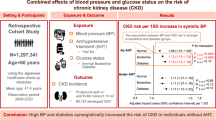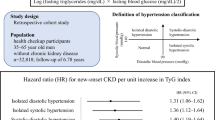Abstract
Objective
To evaluate the interaction effect of blood glucose and blood pressure on the risk of chronic kidney disease (CKD).
Methods
31,165 subjects were selected without CKD at baseline and had completed the first follow-up from “Jinchang cohort”. Cox regression model and restricted cubic splines functions were used to evaluate the effects of blood glucose or pressure on the incidence of CKD and dose-response relationship after adjusting for confounding covariates. Synergic effect was assessed by the multiplicative or additive interaction scale.
Results
Among 31,165 subjects, 1307 new-onset CKD were observed during 68905.78 person-years follow-up, and the incidence density was 18.97 per 1000 person-years. The risk of CKD gradually increased with the increase of blood pressure in diabetes, pre-diabetes and normal groups (Ptrend < 0.05). And, the risk was greatest when SBP/DBP reached ≥150/≥110 mmHg in three groups, and HRs (95% CI) were 1.610 (1.070–2.422), 2.142 (1.396–3.288) and 2.455 (1.941–3.106), respectively. Additionally, among hypertension, pre-hypertension and normal groups, the risk of CKD increased by 16.0%, 14.3% and 25.2% for each 1 mmol/L of FPG. When FPG level was more than 9.0 mmol/L, the risk was greatest and adjusted HRs (95% CI) were 2.856 (2.176–3.748), 2.979 (1.828–4.854) and 7.520 (4.517–12.519). Furthermore, the risk was highest when hypertension was accompanied by diabetes (HR = 4.915, 95% CI: 3.923–6.157). This analysis supported a less than multiplicative effect (HR = 0.634, 95% CI: 0.417–0.964) for the interaction term of diabetes and hypertension, while there was no additive interaction towards CKD in all interaction term.
Conclusions
Blood glucose and pressure were independent risk factors in incidence of CKD, but there was only a negative multiplicative interaction between hypertension and diabetes, but no additive interaction effect between them.




Similar content being viewed by others
Data availability
The datasets used and/or analyzed during the current study are available from the corresponding author on reasonable request and approval by the principal investigator.
References
N.R. Hill, S.T. Fatoba, J.L. Oke et al. Global Prevalence of Chronic Kidney Disease—A Systematic Review and Meta-Analysis. PloS one 11(7), e0158765 (2016)
R. Lozano, M. Naghavi, K. Foreman et al. Global and regional mortality from 235 causes of death for 20 age groups in 1990 and 2010: a systematic analysis for the Global Burden of Disease Study 2010. Lancet 380(9859), 2095–2128 (2012)
L. Zhang, F. Wang, L. Wang et al. Prevalence of chronic kidney disease in China: a cross-sectional survey. Lancet 379(9818), 815–822 (2012)
C.E. Koro, B.H. Lee, S.J. Bowlin, Antidiabetic medication use and prevalence of chronic kidney disease among patients with type 2 diabetes mellitus in the United States. Clin. Therapeutics 31(11), 2608–2617 (2009)
K. Al-Rubeaan, A.M. Youssef, S.N. Subhani et al. Diabetic nephropathy and its risk factors in a society with a type 2 diabetes epidemic: a Saudi National Diabetes Registry-based study. PloS one 9(2), e88956 (2014)
P.A. Sarafidis, S. Li, S.C. Chen et al. Hypertension awareness, treatment, and control in chronic kidney disease. Am. J. Med. 121(4), 332–340 (2008)
J.M. Pascual, E. Rodilla, C. Gonzalez et al. Long-term impact of systolic blood pressure and glycemia on the development of microalbuminuria in essential hypertension. Hypertension 45(6), 1125–1130 (2005)
O. Torffvit, C.D. Agardh, The impact of metabolic and blood pressure control on incidence and progression of nephropathy. A 10-year study of 385 type 2 diabetic patients. J. Diabet Complicat. 15(6), 307–313 (2001)
J. Liu, D. Zhao, J. Liu et al. Prevalence of diabetes mellitus in outpatients with essential hypertension in China: a cross-sectional study. BMJ open 3(11), e003798 (2013)
A.D. Colosia, R. Palencia, S. Khan, Prevalence of hypertension and obesity in patients with type 2 diabetes mellitus in observational studies: a systematic literature review. Diabet. Metab. Syndr. Obes. 6, 327–338 (2013)
Z. Wang, J.M. do Carmo, N. Aberdein et al. Synergistic Interaction of Hypertension and Diabetes in Promoting Kidney Injury and the Role of Endoplasmic Reticulum Stress. Hypertension 69(5), 879–891 (2017)
W. Shi, H. Wang, Y. Zhou et al. Synergistic interaction of hypertension and diabetes on chronic kidney disease: Insights from the National Health and Nutrition Examination Survey 1999-2006. J. Diabet Complicat. 34(2), 107447 (2020)
S. Erfanpoor, K. Etemad, S. Kazempour et al. Diabetes, Hypertension, and Incidence of Chronic Kidney Disease: Is There any Multiplicative or Additive Interaction? Int. J. Endocrinol. Metab. 19(1), e101061 (2021)
Y. Bai, A. Yang, H. Pu et al. Cohort Profile: The China Metal-Exposed Workers Cohort Study (Jinchang Cohort). Int. J. Epidemiol. 46(4), 1095–1096e (2017)
N.K. Foundation, KDOQI Clinical Practice Guideline for Hemodialysis Adequacy: 2015 update. Am. J. Kidney Dis.: Off. J. Natl Kidney Found. 66(5), 884–930 (2015)
A.S. Levey, J. Coresh, Chronic kidney disease. Lancet 379(9811), 165–180 (2012)
T. A. D. Association. 2, Classification and Diagnosis of Diabetes: Standards of Medical Care in Diabetes-2018. Diabetes Care 41(Suppl 1), S13–s27 (2018)
L.S. Liu, 2010 Chinese guidelines for the management of hypertension. Chin. J. Hypertens. 19(08), 701–743 (2011)
L. Desquilbet, F. Mariotti, Dose-response analyses using restricted cubic spline functions in public health research. Stat. Med. 29(9), 1037–1057 (2010)
T. Andersson, L. Alfredsson, H. Källberg et al. Calculating measures of biological interaction. Eur. J. Epidemiol. 20(7), 575–579 (2005)
R. de Mutsert, K.J. Jager, C. Zoccali et al. The effect of joint exposures: examining the presence of interaction. Kidney Int. 75(7), 677–681 (2009)
R.W. Schrier, R.O. Estacio, A. Esler et al. Effects of aggressive blood pressure control in normotensive type 2 diabetic patients on albuminuria, retinopathy and strokes. Kidney Int. 61(3), 1086–1097 (2002)
P.A. James, S. Oparil, B.L. Carter et al. 2014 evidence-based guideline for the management of high blood pressure in adults: report from the panel members appointed to the Eighth Joint National Committee (JNC 8). Jama 311(5), 507–520 (2014)
N.B. Shulman, C.E. Ford, W.D. Hall et al. Prognostic value of serum creatinine and effect of treatment of hypertension on renal function. Results from the hypertension detection and follow-up program. The Hypertension Detection and Follow-up Program Cooperative Group. Hypertension 13(5 Suppl), I80–I93 (1989)
H.M. Perry Jr, J.P. Miller, J.R. Fornoff et al. Early predictors of 15-year end-stage renal disease in hypertensive patients. Hypertension 25(4 Pt 1), 587–594 (1995)
W.G. Walker, J.D. Neaton, J.A. Cutler et al. Renal function change in hypertensive members of the Multiple Risk Factor Intervention Trial. Racial and treatment effects. The MRFIT Research Group. Jama 268(21), 3085–3091 (1992)
P. Muntner, A. Anderson, J. Charleston et al. Hypertension awareness, treatment, and control in adults with CKD: results from the Chronic Renal Insufficiency Cohort (CRIC) Study. Am. J. Kidney Dis.55(3), 441–451 (2010)
A.J. Collins, R.N. Foley, B. Chavers et al. ‘United States Renal Data System 2011 Annual Data Report: Atlas of chronic kidney disease & end-stage renal disease in the United States. Am. J. Kidney Dis. 59(1 Suppl 1), A7, e1–420 (2012)
A.K. Bidani, A.J. Polichnowski, R. Loutzenhiser et al. Renal microvascular dysfunction, hypertension and CKD progression. Curr. Opin. Nephrol. Hypertension 22(1), 1–9 (2013)
H.A. Koomans, J.C. Roos, P. Boer et al. Salt sensitivity of blood pressure in chronic renal failure. Evidence for renal control of body fluid distribution in man. Hypertension 4(2), 190–197 (1982)
E. Pimenta, K.K. Gaddam, S. Oparil et al. Effects of dietary sodium reduction on blood pressure in subjects with resistant hypertension: results from a randomized trial. Hypertension 54(3), 475–481 (2009)
K. Iseki, Y. Ikemiya, K. Kinjo et al. Prevalence of high fasting plasma glucose and risk of developing end-stage renal disease in screened subjects in Okinawa, Japan. Clin. Exp. Nephrol. 8(3), 250–256 (2004)
X. Wang, F. Fan, J. Jia et al. Association of different glucose traits with kidney function decline risk in a Chinese community-based population without chronic kidney disease. Ther. Clin. Risk Manag 14, 1725–1734 (2018)
P. Khajehdehi, L. Malekmakan, M. Pakfetrat et al. Prevalence of chronic kidney disease and its contributing risk factors in southern Iran: a cross-sectional adult population-based study. Iran. J. kidney Dis. 8(2), 109–115 (2014)
K. Yamagata, K. Ishida, T. Sairenchi et al. Risk factors for chronic kidney disease in a community-based population: a 10-year follow-up study. Kidney Int. 71(2), 159–166 (2007)
E.I. Ekinci, G. Jerums, A. Skene et al. Renal structure in normoalbuminuric and albuminuric patients with type 2 diabetes and impaired renal function. Diabet. Care 36(11), 3620–3626 (2013)
R. Ikee, Y. Hamasaki, M. Oka et al. Glucose metabolism, insulin resistance, and renal pathology in non-diabetic chronic kidney disease. Nephron Clin. Pract. 108(2), c163–c168 (2008)
M. Nangaku, Mechanisms of tubulointerstitial injury in the kidney: final common pathways to end-stage renal failure. Intern. Med. 43(1), 9–17 (2004)
D.H. Kang, J. Kanellis, C. Hugo et al. Role of the microvascular endothelium in progressive renal disease. J. Am. Soc. Nephrol. 13(3), 806–816 (2002)
R. Michishita, T. Matsuda, S. Kawakami et al. Hypertension and hyperglycemia and the combination thereof enhances the incidence of chronic kidney disease (CKD) in middle-aged and older males. Clin. Exp. Hypertens. 39(7), 645–654 (2017)
E.L. Schiffrin, M.L. Lipman, J.F. Mann, Chronic kidney disease: effects on the cardiovascular system. Circulation 116(1), 85–97 (2007)
N. Kashihara, Y. Haruna, V.K. Kondeti et al. Oxidative stress in diabetic nephropathy. Curr. Med. Chem. 17(34), 4256–4269 (2010)
M.J. Knol, T.J. VanderWeele, Recommendations for presenting analyses of effect modification and interaction. Int. J. Epidemiol. 41(2), 514–520 (2012)
K.J. Rothman, S. Greenland, A.M. Walker, Concepts of interaction. Am. J. Epidemiol. 112(4), 467–470 (1980)
Acknowledgements
We thank all study participants and staff of the Worker’s Hospital of the Jinchuan Nonferrous Metals Corporation (JNMC) for their generous work, and the interviewers from the Department of Epidemiology and Health Statistics, School of Public Health, Lanzhou University.
Author contributions
The Software, formal analysis, investigation and writing-original draft: MX; conceptualization, methodology, writing-reviewing and editing, supervision: MW; formal analysis and investigation: HY, YZ, YH, JL, LZ; resources: DZ, CY; project administration, supervision: YB. All authors read and approved the final manuscript.
Funding
This study was supported by the National Natural Science Foundation of China (Grant Number: 41705122).
Author information
Authors and Affiliations
Corresponding authors
Ethics declarations
Conflict of interest
The authors declare no competing interests
Ethics approval and consent to participate
This study was approved by the Ethics Committee of School of Public Health, Lanzhou University.
Additional information
Publisher’s note Springer Nature remains neutral with regard to jurisdictional claims in published maps and institutional affiliations.
Rights and permissions
About this article
Cite this article
Wang, M., Xia, M., Yang, H. et al. Interaction effect of blood glucose and pressure on the risk of chronic kidney disease: a population-based prospective cohort study. Endocrine 77, 252–261 (2022). https://doi.org/10.1007/s12020-022-03094-9
Received:
Accepted:
Published:
Issue Date:
DOI: https://doi.org/10.1007/s12020-022-03094-9




